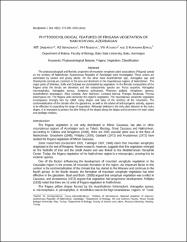Phytosociological features of frigana vegetation of Nakhchivan, Azerbaijan
Citation
Jabbarov, M., Ibragimov, A., Nabieva, F., Atamov, V., & Erkul, S. K. (2020). Phytosociological features of frigana vegetation of Nakhchivan, Azerbaijan. Bangladesh Journal of Botany, 49(2), 273–286. https://doi.org/10.3329/bjb.v49i2.49300Abstract
The phytosociological and floristic properties of mountain xerophyte plant associations (Frigana) spread on the territory of Nakhchivan Autonomous Republic of Azerbaijan were investigated. These unions are dominated by barbed and grassy plants. on the other hand Acantholimon spp., Astragalus spp. and Onobrychis cornuta are common in the area and dominant in the mountainous regions of Nakhchivan. the major parts of Shahbuz, Julfa and Ordubad are dominanted by vegetation. in the floristic composition of the frigana units the shrubs are dominant and the characteristic species are: Pyrus oxyprion, Astragalus microcephalus, Astragalus aureus, Juniperus polycarpos, Rhamnus pallasii, Atraphaxis spinosa, Acantholimon bracteatum, Rhus coriaria, Acer ibericum, Lonicera iberica, Prangos ferulacea, Thymus kotschyanus etc. the frigana units dominate the region's vegetation. the mountainous xerophyte vegetation encompasses strongly torn by relief, rocky slopes, and talus of the territory of the mountains. the continentalization of the climate after the glacial era, as well as the advent of anthropogenic activity, appears to be effective in expanding the range of vegetation. Although skeleton is the only plant bitumen in the rocky slopes, it is important to protect the dive lining of the slopes along the slopes and to prevent the wash away and spoilage residues.


















